Two Alimentary Canal Proteins, Fo-GN and Fo-Cyp1, Act in Western Flower Thrips, Frankliniella occidentalis TSWV Infection
Abstract
Simple Summary
Abstract
1. Introduction
2. Materials and Methods
2.1. Insect Rearing
2.2. Bioinformatics
2.3. RNA Extraction, cDNA Synthesis, RT-PCR, and RT-qPCR
2.4. dsRNA Preparation and RNA Interference (RNAi)
2.5. Immune Challenge with TSWV
2.6. Immunofluorescence Assay
2.7. Fluorescence In Situ Hybridization (FISH) Assay
2.8. Indirect Enzyme-Linked Immunosorbent Assay (ELISA)
2.9. Statistical Analysis
3. Results
3.1. Molecular Characters and Expression Profile of Fo-GN in F. Occidentalis
3.2. Silencing Fo-GN Led to Curtailed TSWV Multiplication
3.3. Molecular Characters of Fo-Cyp1 and Its Expression Profile in F. occidentalis
3.4. Effect of Fo-Cyp1 RNAi on TSWV Multiplication
4. Discussion
Supplementary Materials
Author Contributions
Funding
Data Availability Statement
Conflicts of Interest
References
- Maes, P.; Alkhovsky, S.V.; Bào, Y.; Beer, M.; Birkhead, M.; Briese, T.; Buchmeier, M.J.; Calisher, C.H.; Charrel, R.N.; Choi, I.R.; et al. Taxonomy of the family Arenaviridae and the order Bunyavirales: Update 2018. Arch. Virol. 2018, 163, 2295–2310. [Google Scholar] [CrossRef]
- Rotenberg, D.; Jacobson, A.L.; Schneweis, D.J.; Whitfield, A.E. Thrips transmission of tospoviruses. Curr. Opin. Virol. 2015, 15, 80–89. [Google Scholar] [CrossRef]
- Kormelink, R.; Garcia, M.L.; Goodin, M.; Sasaya, T.; Haenni, A.L. Negative-strand RNA viruses: The plant-infecting counterparts. Virus Res. 2011, 162, 184–202. [Google Scholar] [CrossRef] [PubMed]
- Ribeiro, D.; Jung, M.; Moling, S.; Borst, J.W.; Goldbach, R.; Kormelink, R. The cytosolic nucleoprotein of the plant-infecting bunyavirus tomato spotted wilt recruits endoplasmic reticulum-resident proteins to endoplasmic reticulum export sites. Plant Cell 2013, 25, 3602–3614. [Google Scholar] [CrossRef] [PubMed]
- Feng, Z.; Chen, X.; Bao, Y.; Dong, J.; Zhang, Z.; Tao, X. Nucleocapsid of Tomato spotted wilt tospovirus forms mobile particles that traffic on an actin/endoplasmic reticulum network driven by myosin XI-K. New Phytol. 2013, 200, 1212–1224. [Google Scholar] [CrossRef] [PubMed]
- Wijkamp, I.; van Lent, J.; Kormelink, R.; Goldbach, R.; Peters, D. Multiplication of tomato spotted wilt virus in its vector, Frankliniella occidentalis. J. Gen. Virol. 1993, 74, 341–349. [Google Scholar] [CrossRef]
- Ullman, D.E.; German, T.L.; Sherwood, J.L.; Westcot, D.M.; Cantone, F.A. Tospovirus replication in insect vector cells: Immunocytochemical evidence that the nonstructural protein encoded by the S RNA of tomato spotted wilt tospovirus is present in thrips vector cells. Phytopathology 1993, 86, 900–905. [Google Scholar]
- Gilbertson, R.L.; Batuman, O.; Webster, C.G.; Adkins, S. Role of the insect supervectors Bemisia tabaci and Frankliniella occidentalis in the emergence and global spread of plant viruses. Annu. Rev. Virol. 2015, 2, 67–93. [Google Scholar] [CrossRef]
- Ullman, D.E.; Cho, J.J.; Mau, R.F.L.; Westcot, D.M.; Custer, D.M. Midgut epithelial cells act as a barrier to tomato spotted wilt virus acquisition by adult western flower thrips. Phytopathology 1992, 82, 1333–1342. [Google Scholar] [CrossRef]
- van de Wetering, F.; Goldbach, R.; Peters, D. Tomato-spotted wilt tospovirus ingestion by first instar larvae of Frankliniella occidentalis is a prerequisite for transmission. Phytopathology 1996, 86, 900–905. [Google Scholar] [CrossRef]
- Bandla, M.D.; Campbell, L.R.; Ullman, D.E.; Sherwood, J.L. Interaction of Tomato spotted wilt tospovirus (TSWV) glycoproteins with a thrips midgut protein, a potential cellular receptor for TSWV. Phytopathology 1998, 88, 98–104. [Google Scholar] [CrossRef] [PubMed]
- Jin, M.; Park, J.; Lee, S.; Park, B.; Shin, J.; Song, K.; Ahn, T.; Hwang, S.; Ahn, B.; Ahn, K. Hantaan virus enters cells by clathrin-dependent receptor-mediated endocytosis. Virology 2002, 294, 60–69. [Google Scholar] [CrossRef]
- Whitfield, A.E.; Kumar, N.K.; Rotenberg, D.; Ullman, D.E.; Wyman, E.A.; Zietlow, C.; Willis, D.K.; German, T.L. A soluble form of the Tomato spotted wilt virus (TSWV) glycoprotein GN (GN-S) inhibits transmission of TSWV by Frankliniella occidentalis. Phytopathology 2008, 98, 45–50. [Google Scholar] [CrossRef]
- Badillo-Vargas, I.E.; Chen, Y.; Martin, K.M.; Rotenberg, D.; Whitfield, A.E. Discovery of novel thrips vector proteins that bind to the viral attachment protein of the plant bunyavirus Tomato Spotted Wilt Virus. J. Virol. 2019, 93, e00699-19. [Google Scholar] [CrossRef] [PubMed]
- Kim, C.; Choi, D.; Lee, D.; Khan, F.; Kwon, G.; Ham, E.; Park, J.; Kil, E.J.; Kim, Y. Yearly occurrence of thrips infesting hot pepper in greenhouses and differential damages of dominant thrips. Korean J. Appl. Entomol. 2022, 61, 319–330. [Google Scholar] [CrossRef]
- Bustin, S.A.; Benes, V.; Garson, J.A.; Hellemans, J.; Huggett, J.; Kubista, M.; Mueller, R.; Nolan, T.; Pfaffl, W.M.; Shipley, L.G.; et al. The MIQE guidelines: Minimum information for publication of quantitative real-time PCR experiments. Clin. Chem. 2009, 55, 611–622. [Google Scholar] [CrossRef]
- Livak, K.J.; Schimittgen, T.D. Analysis of relative gene expression data using real time quantitative PCR and the 2-ΔΔCT method. Methods 2001, 25, 402–408. [Google Scholar] [CrossRef]
- SAS Institute Inc. SAS/STAT User’s Guide, Release 6.03 ed.; SAS Institute Inc.: Cary, NC, USA, 1989. [Google Scholar]
- Karouzou, M.V.; Spyropoulos, Y.; Iconomidou, V.A.; Cornman, R.S.; Hamodrakas, S.; Willis, J.H. Drosophila cuticular proteins with the R&R consensus: Annotation and classification with a new tool for discriminating RR-1 and RR-2 sequences. Insect Biochem. Mol. Biol. 2007, 37, 754–760. [Google Scholar]
- Silva, C.P.; Silva, J.R.; Vasconcelos, F.F.; Petretski, M.D.; Damatta, R.A.; Ribeiro, A.F.; Terra, W.R. Occurrence of midgut perimicrovillar membranes in paraneopteran insect orders with comments on their function and evolutionary significance. Arthropod Struct. Dev. 2004, 33, 139–148. [Google Scholar] [CrossRef]
- Han, J.; Rotenberg, D. Integration of transcriptomics and network analysis reveals co-expressed genes in Frankliniella occidentalis larval guts that respond to tomato spotted wilt virus infection. BMC Genom. 2021, 22, 810. [Google Scholar] [CrossRef]
- Wang, P.; Heitman, J. The cyclophilins. Genome Biol. 2005, 6, 226. [Google Scholar] [CrossRef]
- Marks, A.R. Cellular functions of immunophilins. Physiol. Rev. 1996, 76, 631–649. [Google Scholar] [CrossRef]
- Arevalo-Rodriguez, M.; Wu, X.; Hanes, S.D.; Heitman, J. Prolyl isomerases in yeast. Front. Biosci. 2004, 9, 2420–2446. [Google Scholar] [CrossRef]
- Galat, A. Peptidylprolyl cis/trans isomerases (immunophilins): Biological diversity--targets--functions. Curr. Top. Med. Chem. 2003, 3, 1315–1347. [Google Scholar] [CrossRef] [PubMed]
- Handschumacher, R.E.; Harding, M.W.; Rice, J.; Drugge, R.J.; Speicher, D.W. Cyclophilin: A specific cytosolic binding protein for cyclosporin A. Science 1984, 226, 544–547. [Google Scholar] [CrossRef]
- Tian, H.Y.; Hu, Y.; Zhang, P.; Xing, W.X.; Xu, C.; Yu, D.; Yang, Y.; Luo, K.; Li, M. Spodoptera litura cyclophilin A is required for Microplitis bicoloratus bracovirus-induced apoptosis during insect cellular immune response. Arch. Insect Biochem. Physiol. 2019, 100, e21534. [Google Scholar] [CrossRef]
- Hu, Y.; Liang, Y.P.; Tian, H.Y.; Xu, C.X.; Yu, D.; Zhang, P.; Ye, H.; Li, M. Microplitis bicoloratus bracovirus regulates cyclophilin A-apoptosis-inducing factor interaction to induce cell apoptosis in the insect immunosuppressive process. Arch. Insect Biochem. Physiol. 2022, 110, e21877. [Google Scholar] [CrossRef]
- Daugas, E.; Susin, S.A.; Zamzami, N.; Ferri, K.F.; Irinopoulou, T.; Larochette, N.; Prévost, M.C.; Leber, B.; Andrews, D.; Penninger, J. Mitochondrio-nuclear translocation of AIF in apoptosis and necrosis. FASEB J. 2000, 14, 729–739. [Google Scholar] [CrossRef] [PubMed]
- Candé, C.; Vahsen, N.; Kouranti, I.; Schmitt, E.; Daugas, E.; Spahr, C.; Luban, J.; Kroemer, R.T.; Giordanetto, F.; Garrido, C. AIF and cyclophilin A cooperate in apoptosis-associated chromatin lysis. Oncogene 2004, 23, 514–521. [Google Scholar] [CrossRef]
- Ullman, D.E.; Cho, J.J.; Mau, R.F.; Hunter, W.B.; Westcot, D.M.; Custer, D.M. Thrips-tomato spotted wilt virus interactions: Morphological, behavioral and cellular components influencing thrips transmission. In Advances in Disease Vector Research; Harris, K.F., Ed.; Springer: New York, NY, USA, 1992; Volume 9, pp. 195–240. [Google Scholar]
- Wang, H.; Xu, D.; Pu, L.; Zhou, G. Southern rice black-streaked dwarf virus alters insect vectors’ host orientation preferences to enhance spread and increase Rice ragged stunt virus co-infection. Virol. J. 2014, 104, 196–201. [Google Scholar] [CrossRef] [PubMed]
- Wang, Q.; Li, J.; Dang, C.; Chang, X.; Feng, Q.; Stanley, D.; Ye, G. Rice dwarf virus infection alters green rice leafhopper host preference and feeding behavior. PLoS ONE 2018, 13, e0203364. [Google Scholar] [CrossRef] [PubMed]
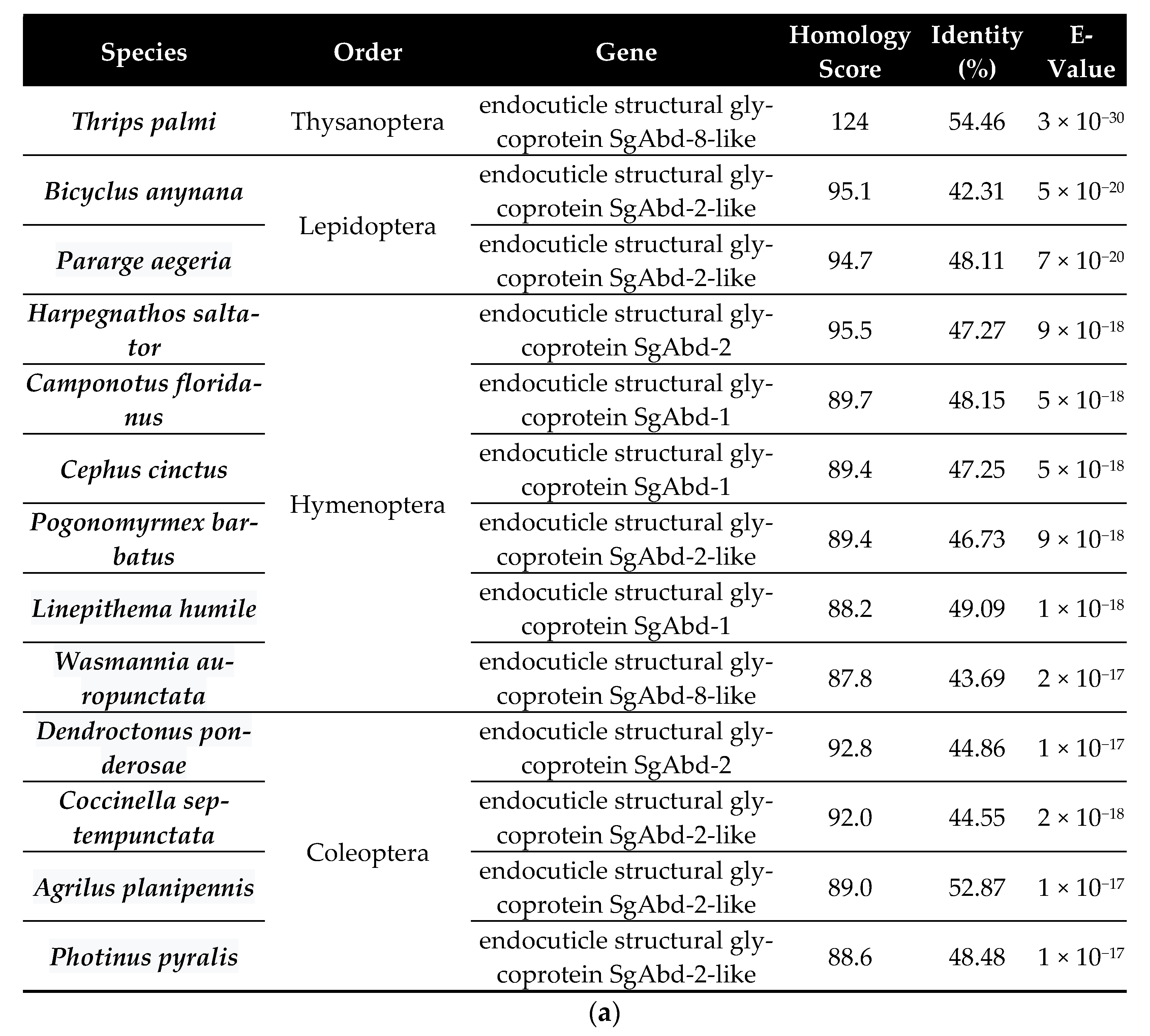

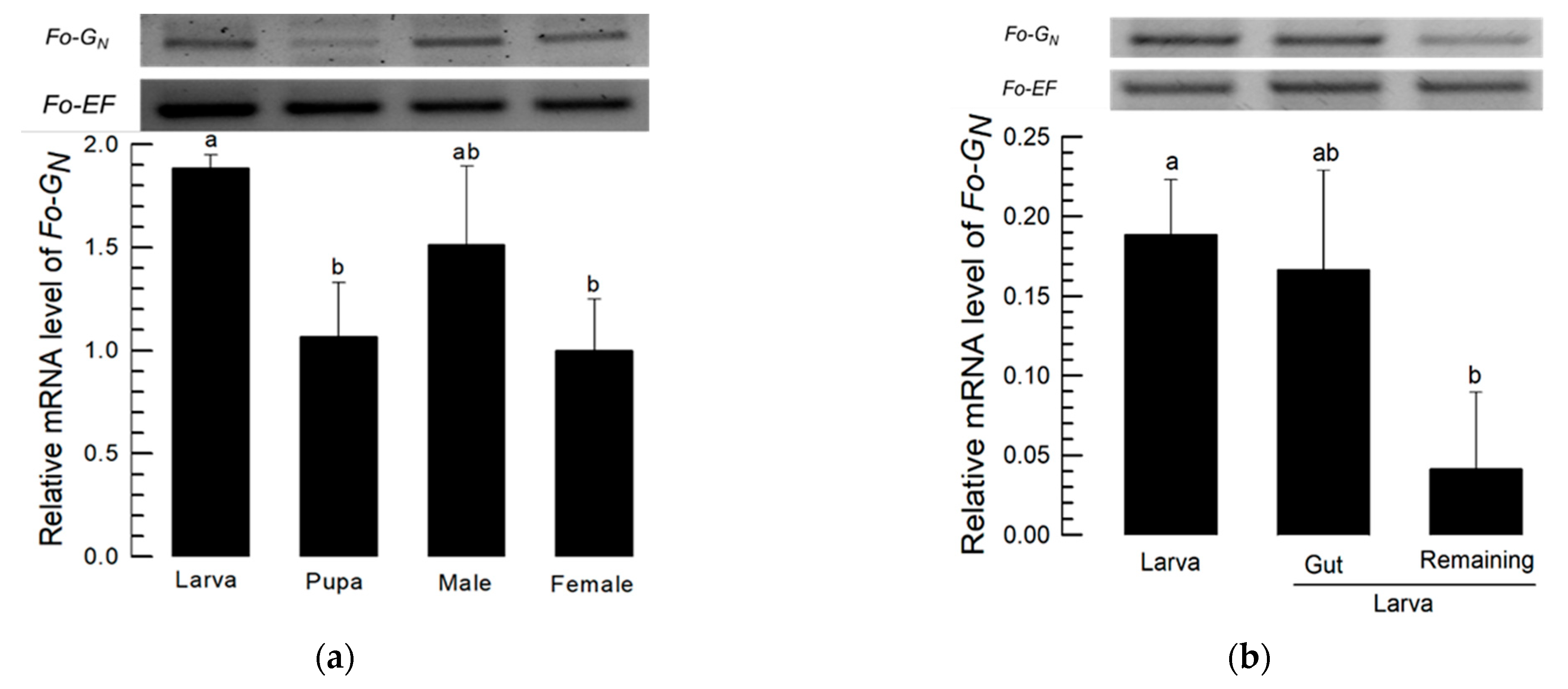
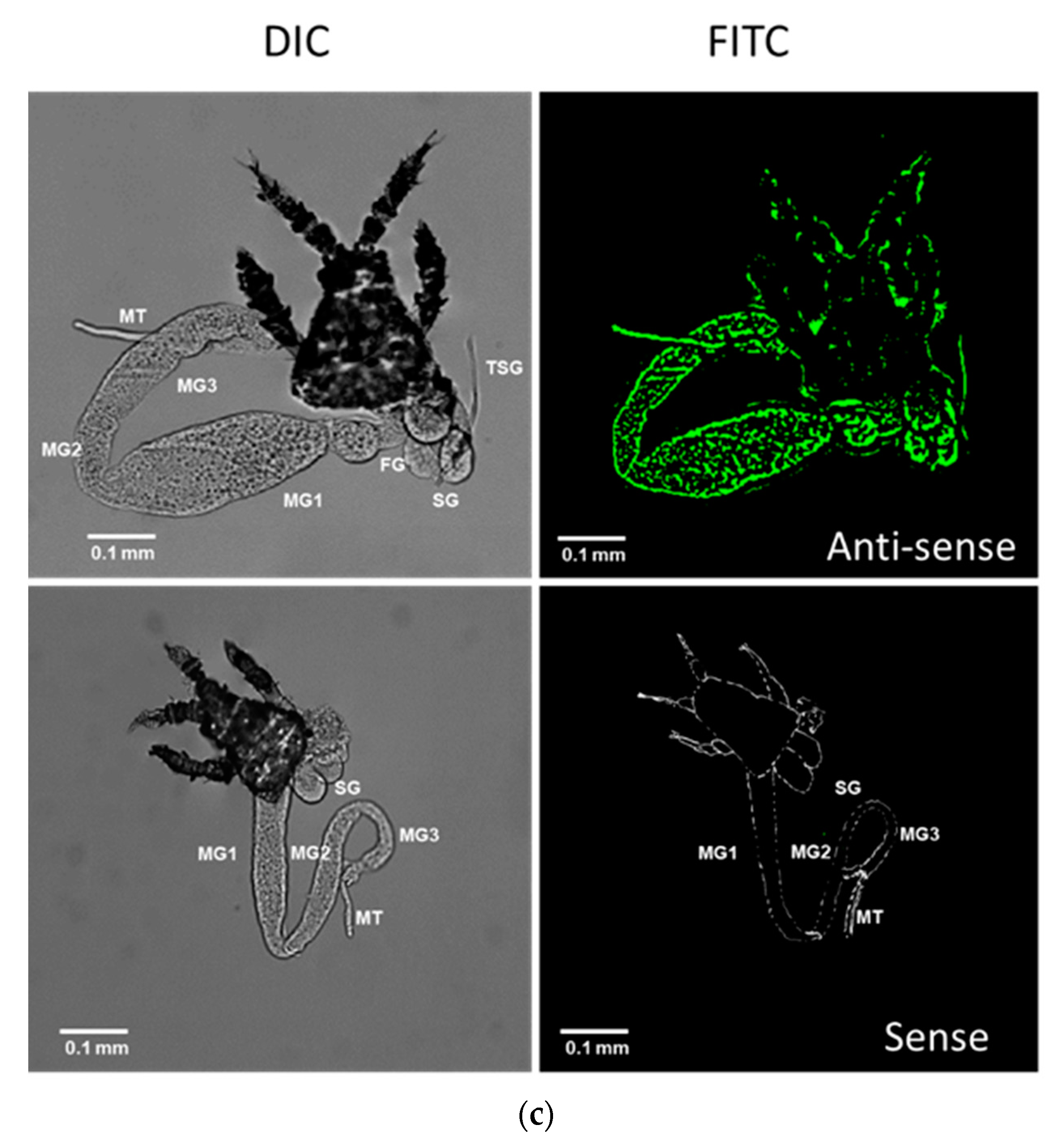
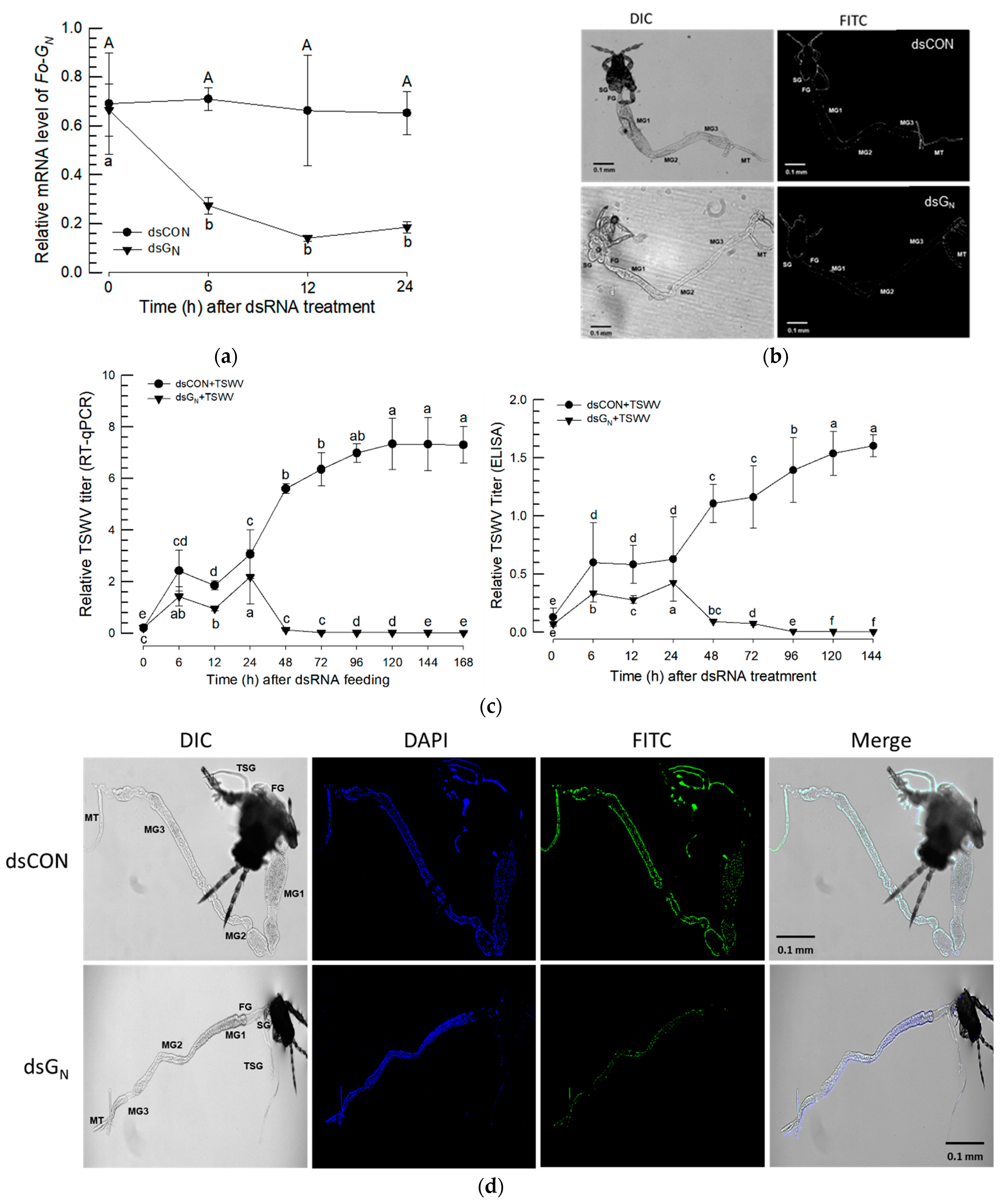
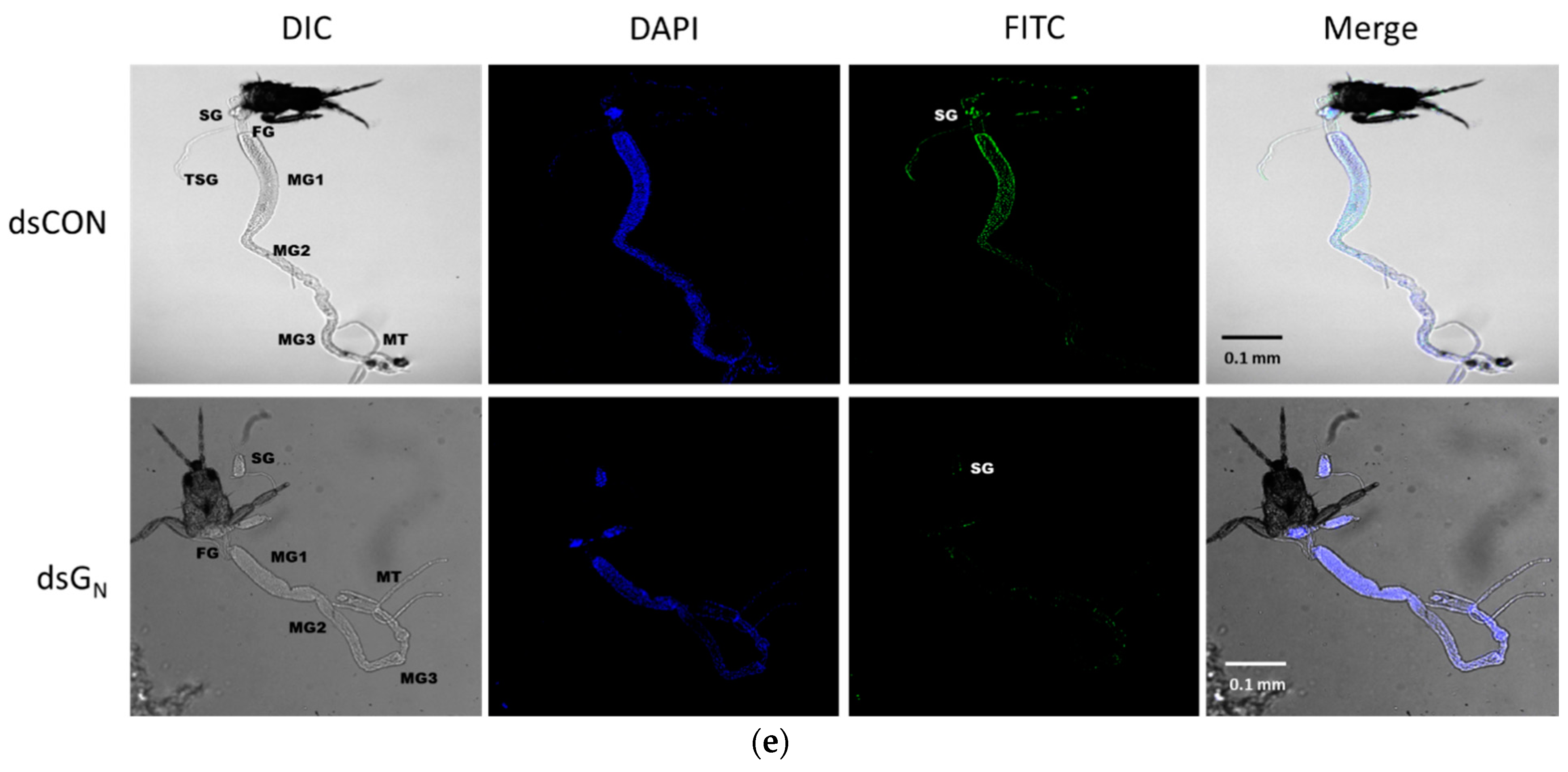
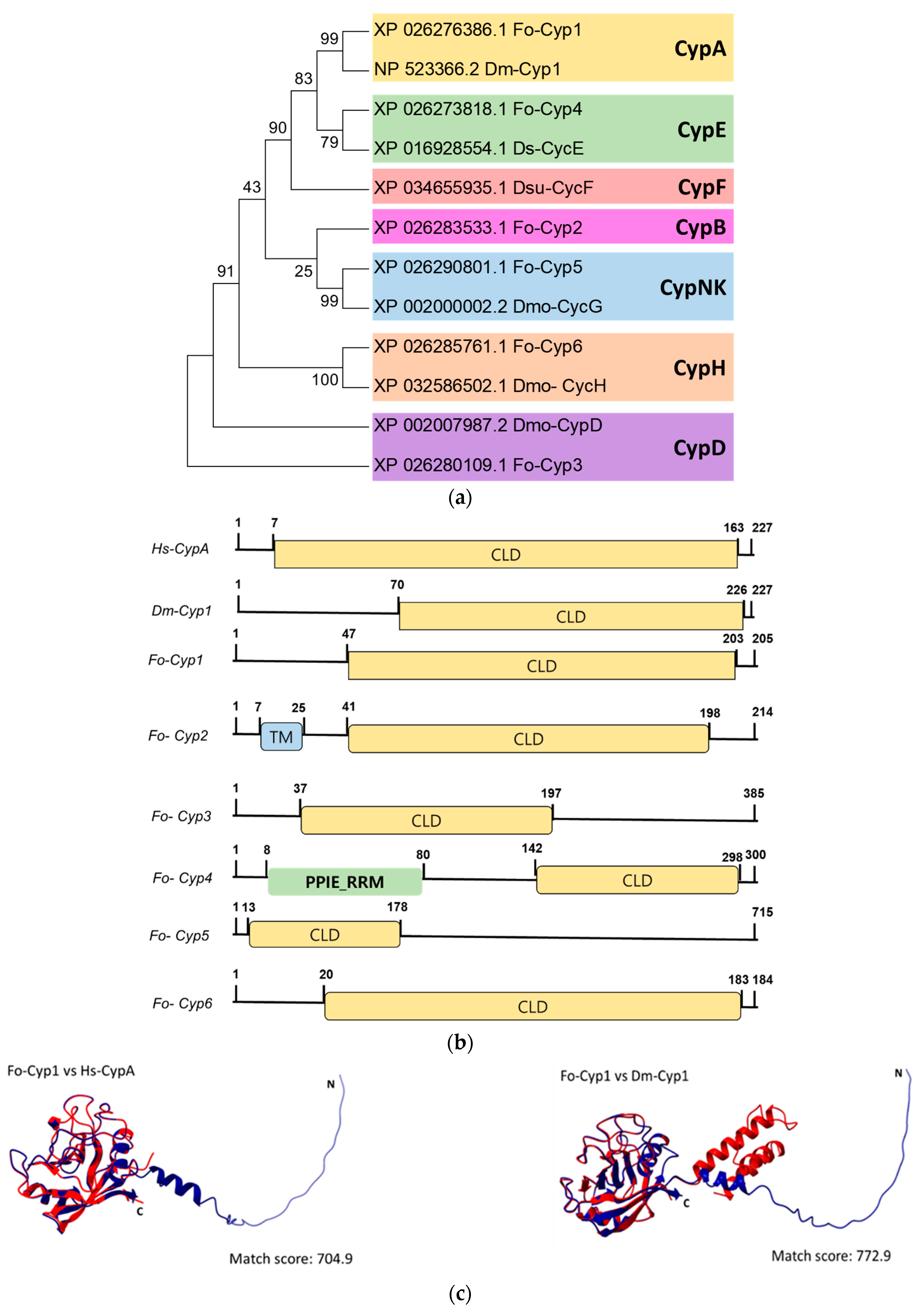

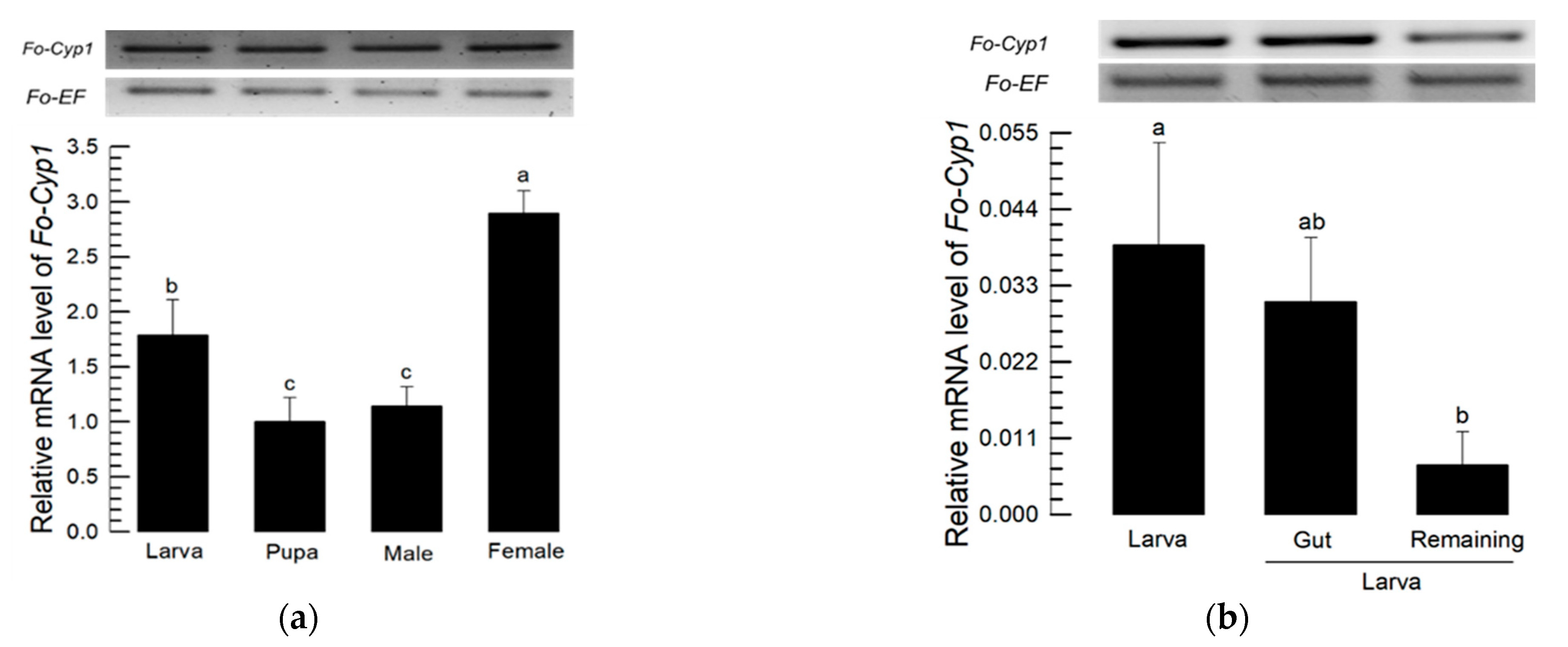
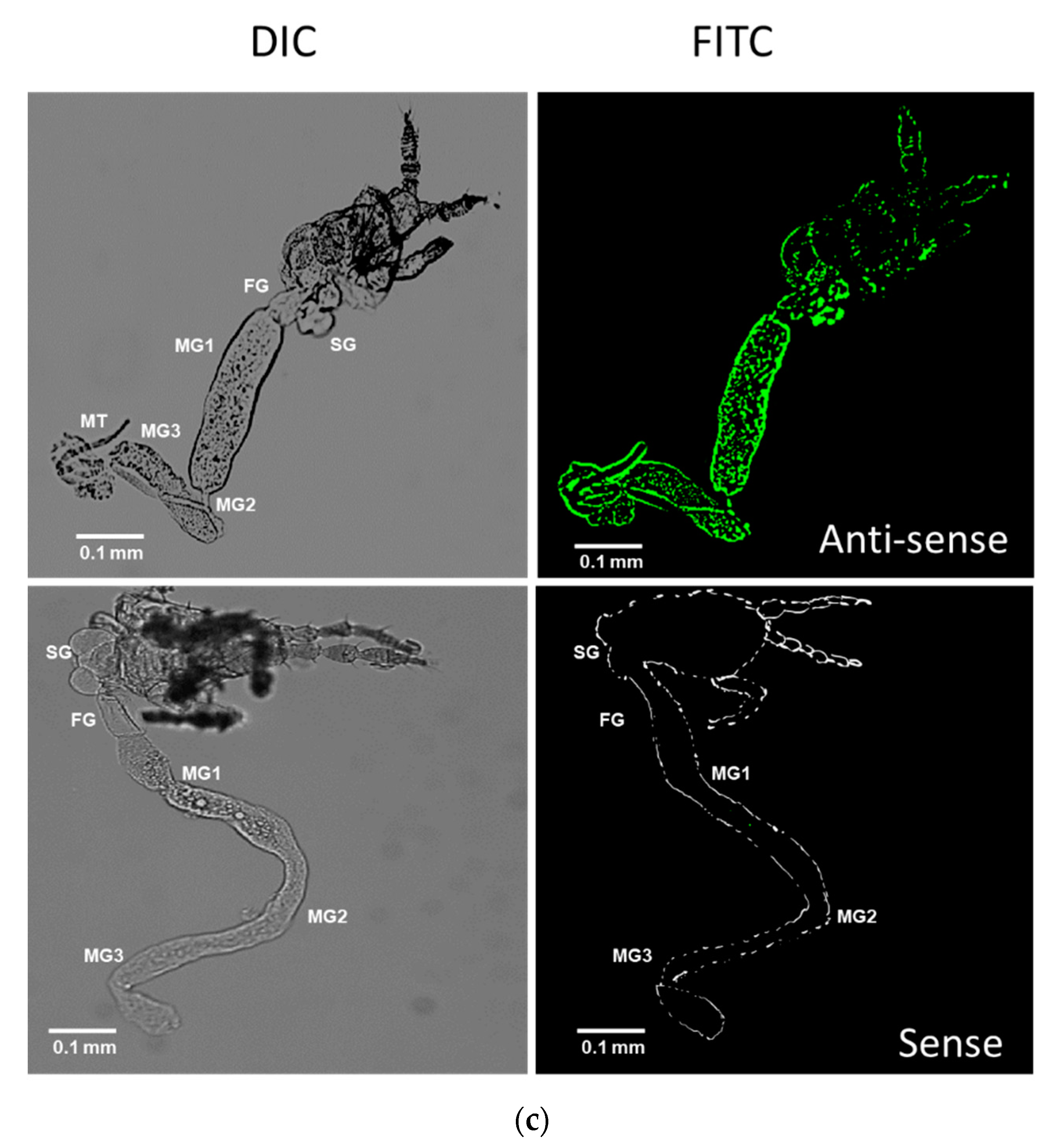
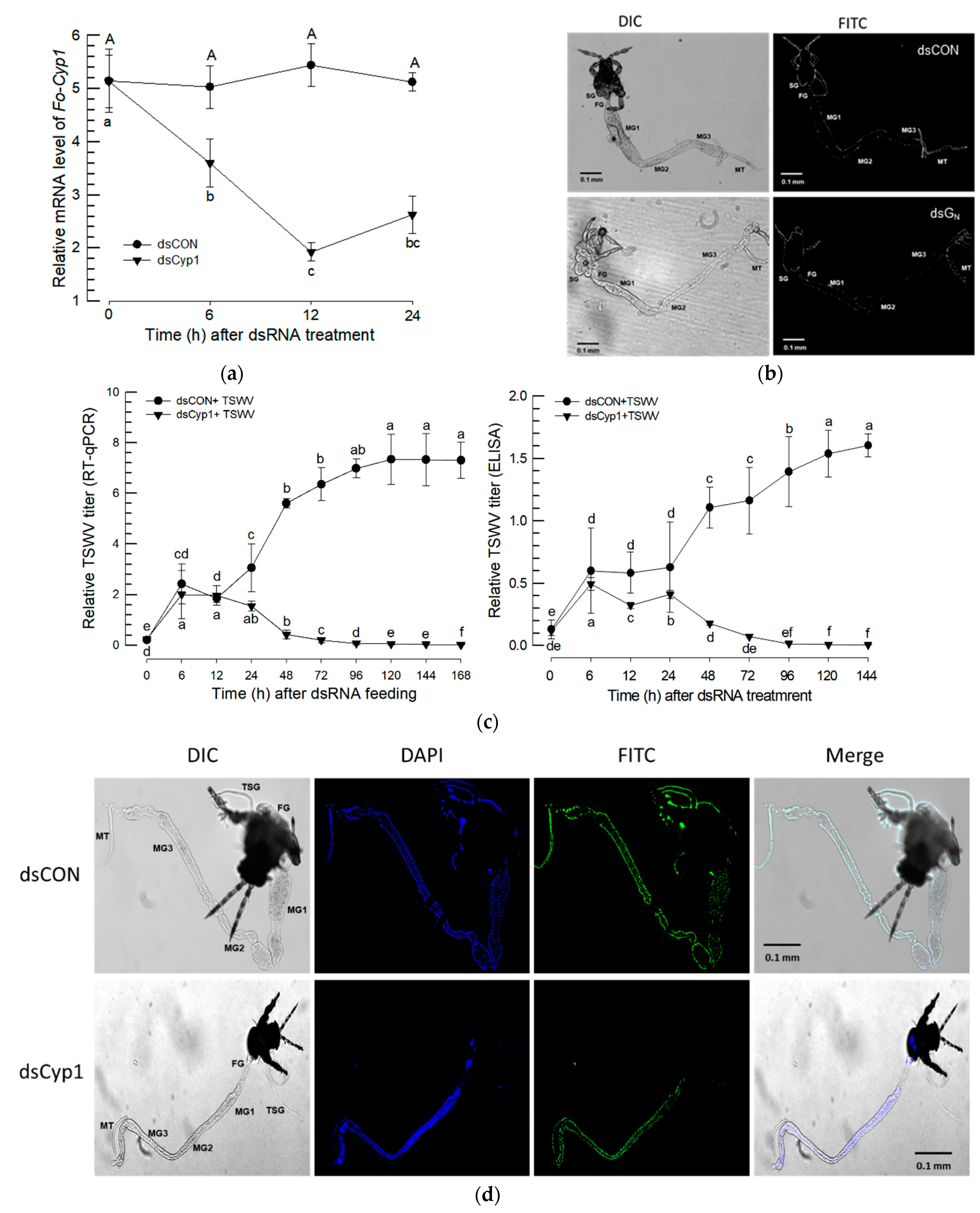
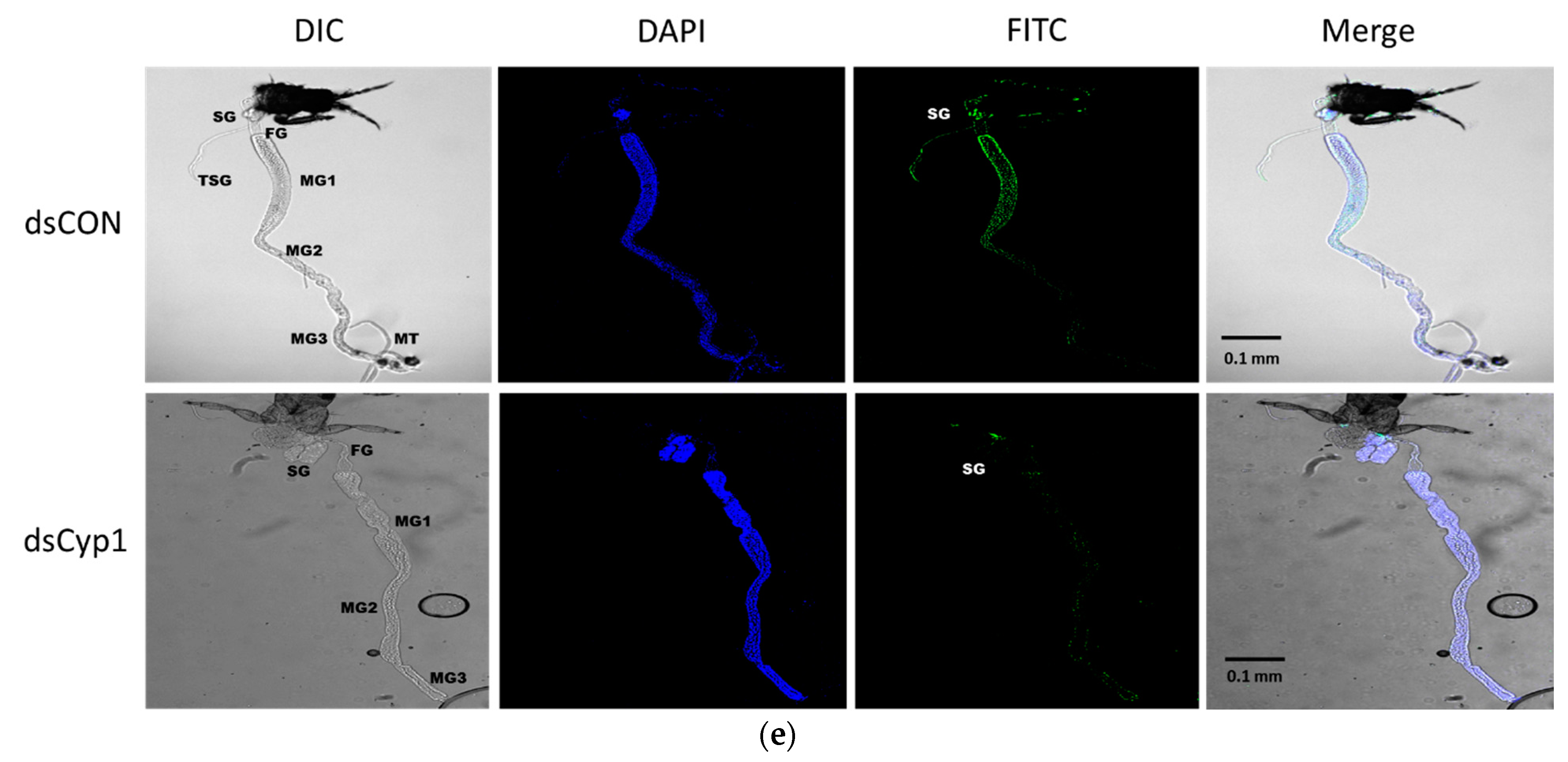
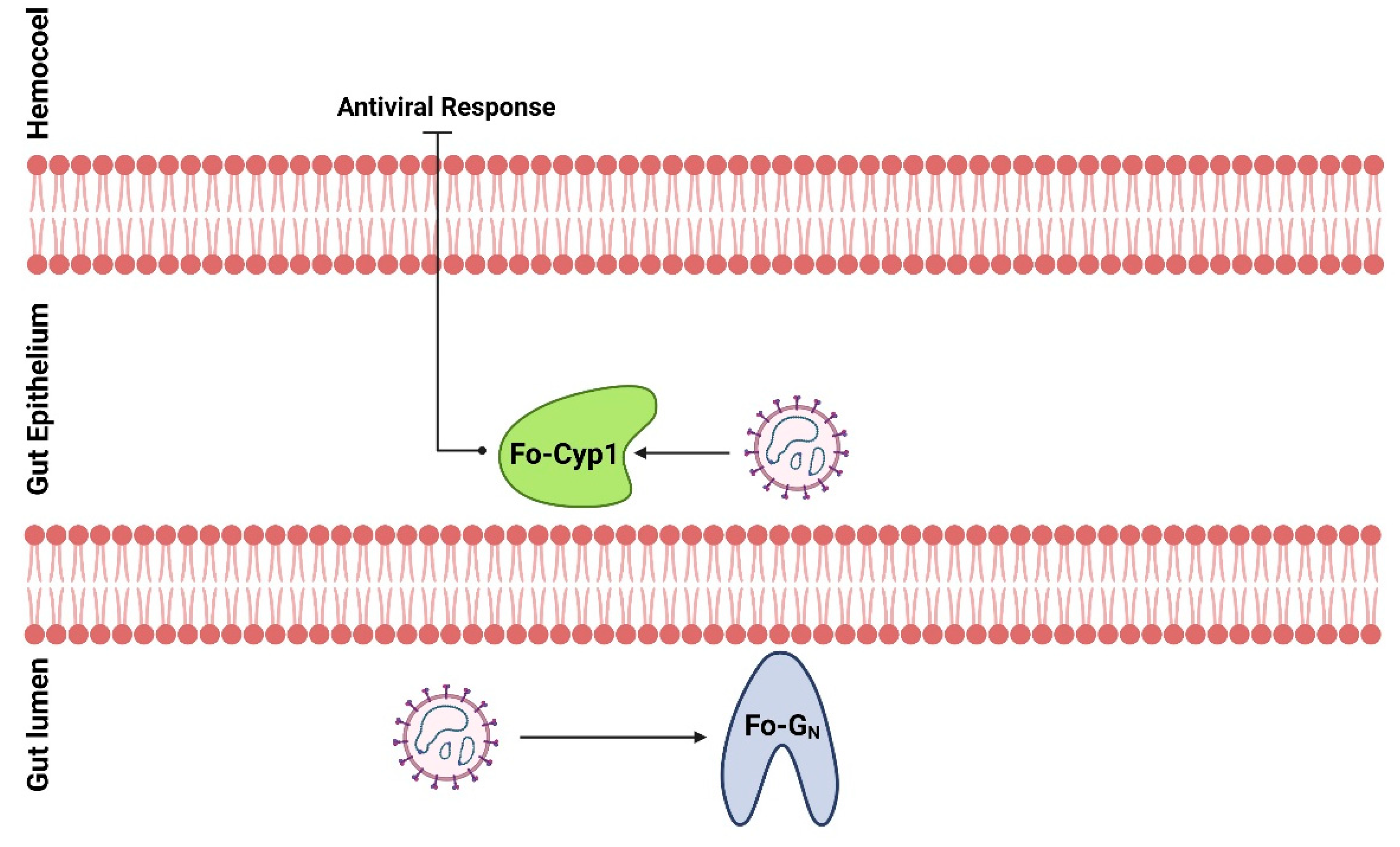
Disclaimer/Publisher’s Note: The statements, opinions and data contained in all publications are solely those of the individual author(s) and contributor(s) and not of MDPI and/or the editor(s). MDPI and/or the editor(s) disclaim responsibility for any injury to people or property resulting from any ideas, methods, instructions or products referred to in the content. |
© 2023 by the authors. Licensee MDPI, Basel, Switzerland. This article is an open access article distributed under the terms and conditions of the Creative Commons Attribution (CC BY) license (https://creativecommons.org/licenses/by/4.0/).
Share and Cite
Khan, F.; Stanley, D.; Kim, Y. Two Alimentary Canal Proteins, Fo-GN and Fo-Cyp1, Act in Western Flower Thrips, Frankliniella occidentalis TSWV Infection. Insects 2023, 14, 154. https://doi.org/10.3390/insects14020154
Khan F, Stanley D, Kim Y. Two Alimentary Canal Proteins, Fo-GN and Fo-Cyp1, Act in Western Flower Thrips, Frankliniella occidentalis TSWV Infection. Insects. 2023; 14(2):154. https://doi.org/10.3390/insects14020154
Chicago/Turabian StyleKhan, Falguni, David Stanley, and Yonggyun Kim. 2023. "Two Alimentary Canal Proteins, Fo-GN and Fo-Cyp1, Act in Western Flower Thrips, Frankliniella occidentalis TSWV Infection" Insects 14, no. 2: 154. https://doi.org/10.3390/insects14020154
APA StyleKhan, F., Stanley, D., & Kim, Y. (2023). Two Alimentary Canal Proteins, Fo-GN and Fo-Cyp1, Act in Western Flower Thrips, Frankliniella occidentalis TSWV Infection. Insects, 14(2), 154. https://doi.org/10.3390/insects14020154





